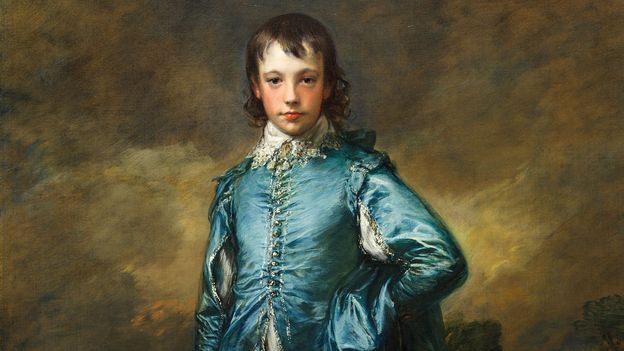The private life of a masterpiece


After Blue Boy arrived in the US, it became famous, appearing on ceramics, textiles and thousands of reproduction prints. How it was interpreted by its new host nation was also subject to the winds of cultural change. According to Hedquist, a formative episode was the so-called “lavender scare” in the 1950s in which gay men and women were perceived to be threats to national security and were hounded from government office. Common stereotypes of gay deportment – now laughable in their ignorance – such as lacy cuffs and fancy shoes, were cited as signifiers of these “enemies within”.
A visual shorthand
It led to sinister comedic parodies of perceived gay behaviour in popular culture, with outlets including cartoon strips. In Mad Magazine in September 1970, one cartoon featured a character called Prissy Percy, who is teased by a group of sporty, all-American boys – the final scene reveals Percy to be Blue Boy. The cartoon’s covert message and sentiment is homophobic; Hedquist sees it as Blue Boy’s first “outing”. A Dennis the Menace cartoon published in 1976 also featured the Blue Boy, where he was again labelled a “sissy”.
“The emerging ideas about how people see gay men is so important to how the Blue Boy becomes an iconic image,” says Hedquist, “first of all as a source of ridicule and then as a reappropriation.”
The reappropriation came in the form of a gay magazine first published in 1974, called “Blue Boy”. The cover of the first issue featured a photo of Dale, a boxer from Ohio, in a homage to Gainsborough’s masterpiece, albeit without any trousers and a conveniently repositioned hat. The magazine, brainchild of entrepreneur Don N Embinder, continued publishing until December 2007, and advertised products and services whose recurrent symbol was the Blue Boy. It recommended gay-friendly hotels and bars and fostered a sense of community. “The first gay travel agency was called ‘Blue Boy’,” Hedquist explains. “They had cruises and hotels where men could be openly gay, wearing ‘Blue Boy’ T-shirts and carrying ‘Blue Boy’ travel bags. It was a full reappropriation and a celebration that the Blue Boy was gay.” In the period after the Stonewall riots, this was a galvanising symbol, and has left a legacy of multiple “Blue Boy” gay bars around the world.








